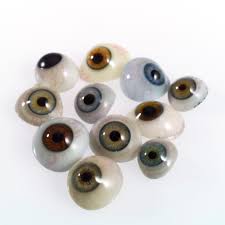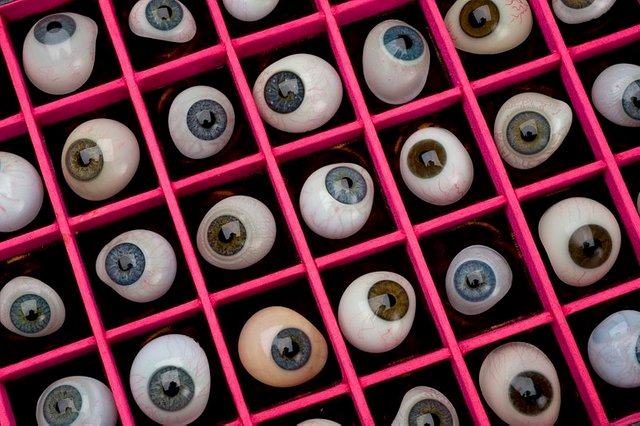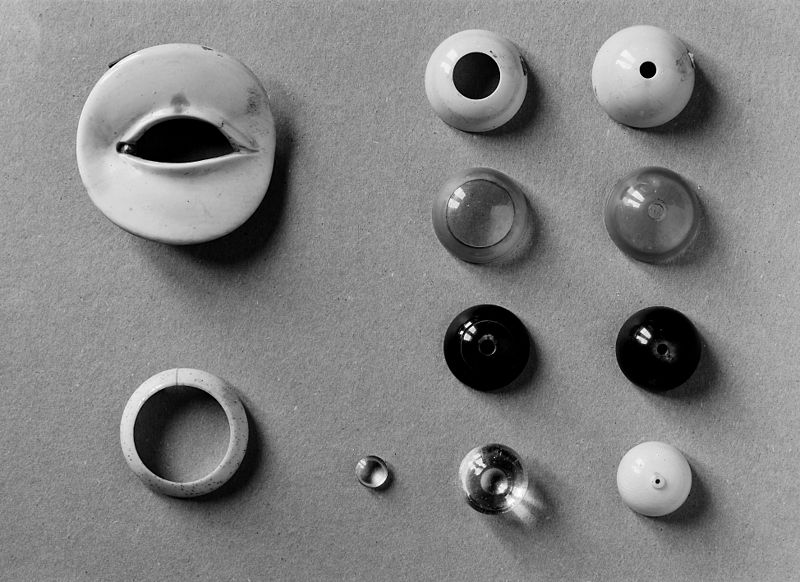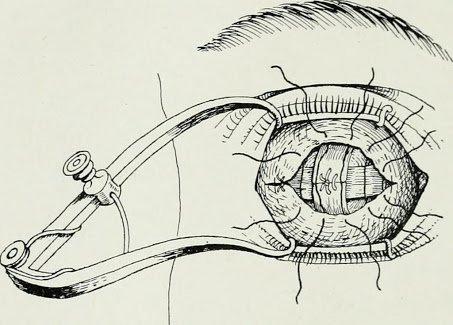How an Artificial Eye is Made.
.jpeg)
A selection of glass eyes from an optician's glass eye case. Credit : Wikimedia Commons
An artificial eye, oscular prosthesis or glass eye is a replacement for an absent natural eye lost as a result of injury or disease. The replacement is visionless, the prosthesis fits over an orbital implant and under the eyelids and serves as a cosmetic enhancement. The ocular prosthesis has the shape of a convex shell and is made of medical grade plastic acrylic. In past, before the invention of artificial eyes, anyone who lost his or her natural eyes usually wore a patch. An artificial eye can be attached to muscles in the socket to provide eye movement. Someone with an artificial eye is totally blind on the affected side an has “monocular” which means one sided vision.
A few artificial eyes today are usually made of plastic and has a durability of 10years.Children or infants who lost their natural eyes and undergo surgery for an artificial eye would require a replacement of the artificial eye for about four to five times until they become adults. Thousand of people annually lose lost their eyes from accident. Some are inherited cases whereby an individual with a birth defect (microphthalmia) which does not allow the eye to develop it’s normal size , have light perception or totally blind. Also a situation where some people are born with the congenital absence of one or both eyes (anophthalmia) is the reason for an artificial eye. It is usually difficult to fix and artificial eye in this case because it takes time to prepare, most times a surgery is required. There also other cases that results to eye lost, such as Retinoblastoma cancer or tumor, glaucoma and cataracts.
Types of Artificial Eyes
There are several types of artificial eyes used by ocularist (eye surgeon) , but i will be talking about the "moulded" prosthesis and the "cosmetic shell".
Moulded prosthesis is a common type of artificial eye that is made individually and specifically for a particular person, the production of moulded prosthesis is dependent on the impression gotten from the eye sucket. A moulded eye is unique and provide a life-alike with the natural eye.
While the Cosmetic Shell is another type of eye that is worn over an existing eye. The essence is to disguise the disfigurement of an eye. Ideally, the Cosmetic Shell is meant to cover an existing eye and for it to become successful is tolerance. The stipulated time to wear the Cosmetic eye is about twelve hours the essence is to allow space in depth for the added shell and have a marked decrease in sensation. It is advised that the patient should always remove the eye at night this is to allow oxygen in the eye and to avoid shrinkage.
Materials Used in Making an Artificial Eye
Plastic is the major material used in making an artificial eye. Wax and paris plaster are used to make the molds. An alginate white powder is used in the molding process. Paints and other decorating materials are used to add color life-like features to the prosthesis.
How an Artificial Eye is Manufactured
The actual time to produce an ocular prosthesis from the start to finish depends on the ocularist and the patient. The average time is usually 3.5 hours. Ocularists are still looking for ways to reduce the time.
There are two types of prostheses, the very thin shell type prosthesis and the full modified impression type prostheses. The very thin type is fitted over a blind, disfigured eye or over an eye which has been just partially removed. While the full modified impression type is made for those who have had eyeballs completely removed. I will describe below the artificial eye manufacturing process for the full modified impression type.
The ocularist will inspect the condition of the eye socket. Measure the vertical and horizontal dimensions as well as the boundaries of the socket.
The ocularist will then paint the iris. After then, the iris button will be selected to match the individual patient’s own iris diameter. Normally, iris diameter range from 0.4-0.52 in (10-13mm). The iris will be painted on the back, flat side of the button and checked against the patient's iris by reversing the button so that the color can be seen through the dome of plastic. After the color, the ocularist will remove the plastic disc, which prevents contraction of the eye socket.
After that, the next thing for the ocularist to do is to hand carve a wax molding shell which has aluminum iris button embedded in it that duplicates the painted iris button. The wax shell is then fitted into the patient’s eye socket as to match the irregular boundary of the eye socket. In some occasions, the shell may have to be reinserted multiple times until the aluminum iris button is aligned with the patient’s remaining eye. If it is fitted properly, there is usually two relief holes made in the wax shell.
The impression is made using alginate, a white powder made from seaweed that is mixed with water to form a cream, this is also used by dentists to make impressions of gums. After mixing, the cream is placed on the back side of the molding shell and the shell is inserted into the socket. The alginate gels in about two minutes and precisely duplicates the individual eye socket. The wax shell is removed, with the alginate impression of the eye socket attached to the back side of the wax shell.
The iris color will be rechecked as ascertain if any necessary changes are made. The plastic conformer is then reinserted so that the final steps can be completed.
A plaster-of-paris cast is made of the mold of the patient's eye socket. After the plaster has hardened which typical takes about seven minutes, the wax and alginate mold is removed and discarded. The aluminum iris button has left a hole in the plaster mold into which the painted iris button is placed. White plastic is then put into the cast, the two halves of the cast are put back together and then placed under pressure and plunged into boiling water. This reduces the water temperature and the plastic is thus cured under pressure for about 23 minutes. The cast will then be removed from the water and cooled.
The plastic has hardened in the shape of the mold with the painted iris button imbedded in the proper place. About 0.5 mm of plastic is then removed from the anterior surface of the prosthesis. The white plastic, which overlaps the iris button, is ground down evenly around the edge of the button. This simulates how the sclera of the living eye slightly overlaps the iris. The sclera is colored using paints, chalk, pencils, colored thread, and a liquid plastic syrup to match the patient's remaining eye. Any necessary alterations to the iris color can also be made at this point.
And finally, the prosthesis is then returned to the cast. Clear plastic is placed in the anterior half of the cast and the two halves are again joined, placed under pressure, and returned to the hot water. The final processing time is about 30 minutes. The cast is then removed and cooled, and the finished prosthesis is removed. Grinding and polishing the prosthesis to a high luster is the final step. This final polishing is crucial to the ultimate comfort of the patient. The prosthesis is finally ready for fitting.
Methods of Fitting an Artificial Eye
There are two major methods of fitting an artificial eye the enucleation method and the evisceration method. A damaged or diseased infected eye can be replaced by an ophthalmologist. Using the enucleation method, the eye surgeon removes the natural eye and replace it with an artificial eye. The eyeball is removed by severing the muscles which are connected to the scores (white eyeball) after that the ophthalmologist ( eye surgeon) then cuts the optic nerve and removes the eye from the socket. After that, an implant is then placed into the Society restore lost volume and give the artificial eye some movement, then the wound will be closed.Another method to replace a damaged or diseased eye is with evisceration. Here, the contents of the eyeball are removed, the surgeon makes an incision around the iris and removes the contents of the eyeball. After this, the eye surgeon will then place a ball made of plastic, glass or silicone (inert materials) inside the eyeball and then close the wound.
After the surgery, the surgeon will round up by placing a plastic disc ( conformer) into the socket. The plastic disc prevents shrinking of the socket and retains good pockets for the prosthesis. Plastic disc are made from hard plastic or silicone. After the surgery, it will take the patient about four to Six weeks to heal. After then, a professional ocularist will make and fit the artificial eye.
Artificial Eye That Can See
Unbelievable right?...... But let’s see.
Science is improving on a daily basis, and scientists are working tirelessly to make the impossible become possible. Just recently, scientists say they have actually cracked the neural “code” in a mouse’s retina to produce a device that will restore near normal sightings blind mouse. Scientists also said they have decode the same code in a monkey’s retina, this is a major bionic breakthrough “an artificial human eye that can see “ isn’t it?. The scientist claimed that, since they can make a blind mouse retinas see, that there is every possibility that they can do same in humans.
Currently, human prosthetic eyes have electrodes that stimulate the retina’s output cells known as ganglion cells, even though the eye’s hardware is destroyed by diseases that cause blindness, they remain intact. The simulator only allows the blind to see through visual fields. For a damaged eye to be restored and able to see again, scientists say artificial eyes must incorporate the code that allows the retina to translate signals from photoreceptors to meaningful pictures. Let us all hope that this research will come through.
Summary
This article is an insight on how the artificial eyes are made. If you have a damaged or cancerous eyes. I will advice you visit an eye doctor or ocularist.
You may be concerned about caring for and living with your artificial eye. You may find it hard to care for the artificial eye at first, but you will be able to adjust with time.
It takes time to adjust when cancer or its treatments affect your eyes and vision. Some people find it helps to talk to others about changes to their sight or appearance. You may also be coping with new sensations, such as feeling like the eye is still there when it has been removed. Talk to your eye doctor about the available way to help you cope with your emotions and daily life with an artificial eye.
Thanks for visiting my blog!
References
- An Artificial Eye
- Canadian Cancer Society
- The Artificial Eye Clinic
- Oscular Prothesis - Wikipedia
- An Artificial Eye That Can See
- Types of Artificial eyes
.gif)


.jpg)
